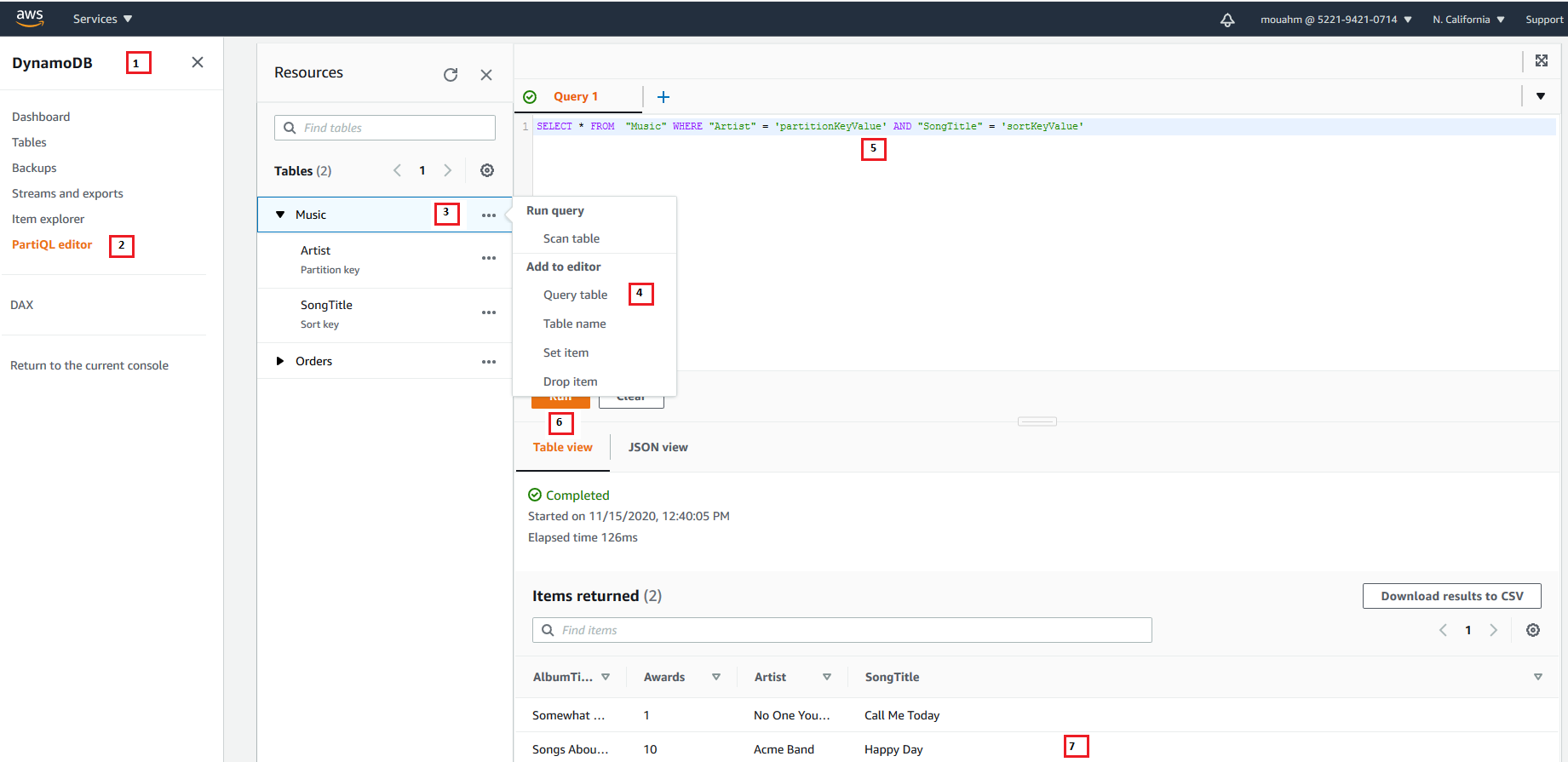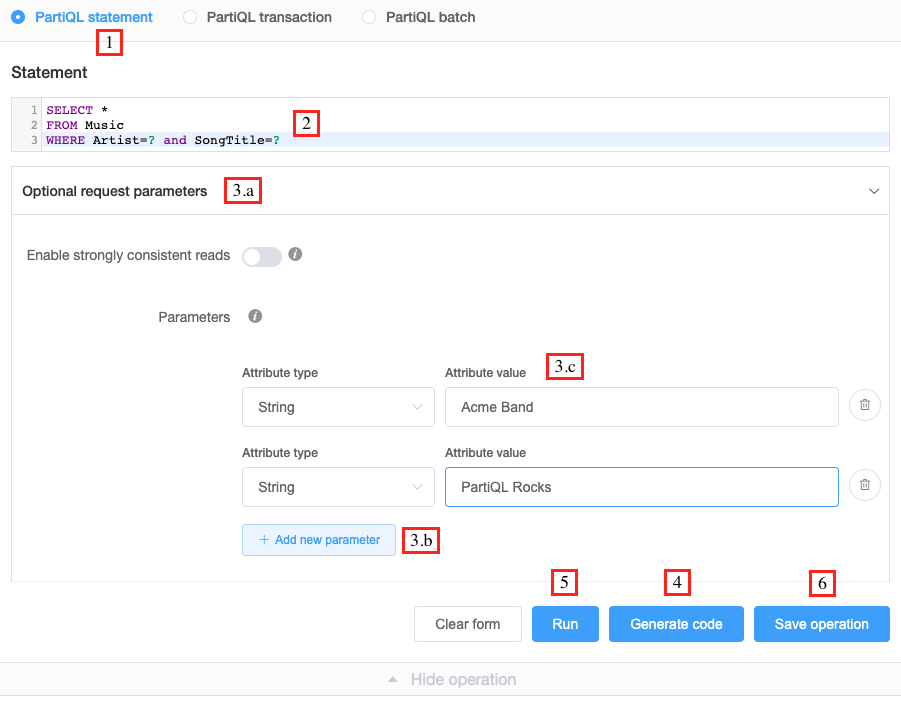Terjemahan disediakan oleh mesin penerjemah. Jika konten terjemahan yang diberikan bertentangan dengan versi bahasa Inggris aslinya, utamakan versi bahasa Inggris.
Terjemahan disediakan oleh mesin penerjemah. Jika konten terjemahan yang diberikan bertentangan dengan versi bahasa Inggris aslinya, utamakan versi bahasa Inggris.
Bagian ini menjelaskan cara menggunakan PartiQL untuk DynamoDB dari konsol Amazon DynamoDB, (), dan DynamoDB. AWS Command Line Interface AWS CLI APIs
Dalam contoh berikut, tabel DynamoDB yang ditentukan dalam tutorial Mulai menggunakan DynamoDB adalah prasyarat.
Untuk mengunduh dan menggunakan No SQL workbench untuk membangun pernyataan PartiQL for DynamoDB pilihoperasi PartiQL di sudut kanan atas pembuat No Workbench for DynamoDB Operation. SQL
- Console
-

Masuk ke AWS Management Console dan buka konsol DynamoDB di. https://console.aws.amazon.com/dynamodb/
-
Di panel navigasi di sisi kiri konsol, pilih editor PartiQL.
-
Pilih tabel Musik.
-
Pilih tabel Kueri. Tindakan ini menghasilkan kueri yang tidak akan menghasilkan pemindaian tabel penuh.
-
Ganti
partitionKeyValuedengan nilai stringAcme Band. GantisortKeyValuedengan nilai stringHappy Day. -
Pilih tombol Jalankan.
-
Anda dapat melihat hasil kueri dengan memilih tampilan Tabel atau tombol JSONtampilan.
- NoSQL workbench
-

-
Pilih pernyataan PartiQL.
-
Masukkan pernyataan PartiQL SELECT berikut
SELECT * FROM Music WHERE Artist=? and SongTitle=? -
Untuk menentukan nilai parameter
ArtistdanSongTitle:-
Pilih Parameter permintaan opsional.
-
Pilih Tambahkan parameter baru.
-
Pilih jenis atribut string dan nilai
Acme Band. -
Ulangi langkah b dan c, lalu pilih jenis string dan nilai
PartiQL Rocks.
-
-
Jika Anda ingin membuat kode, pilih Buat kode.
Pilih bahasa yang Anda inginkan dari tab yang ditampilkan. Sekarang Anda dapat menyalin kode ini dan menggunakannya dalam aplikasi Anda.
-
Jika Anda ingin operasi segera dijalankan, pilih Jalankan.
-
- AWS CLI
-
-
Buat item dalam
Musictabel menggunakan pernyataan INSERT PartiQL.aws dynamodb execute-statement --statement "INSERT INTO Music \ VALUE \ {'Artist':'Acme Band','SongTitle':'PartiQL Rocks'}" -
Ambil item dari tabel Musik menggunakan pernyataan SELECT PartiQL.
aws dynamodb execute-statement --statement "SELECT * FROM Music \ WHERE Artist='Acme Band' AND SongTitle='PartiQL Rocks'" -
Perbarui item dalam
Musictabel menggunakan pernyataan UPDATE PartiQL.aws dynamodb execute-statement --statement "UPDATE Music \ SET AwardsWon=1 \ SET AwardDetail={'Grammys':[2020, 2018]} \ WHERE Artist='Acme Band' AND SongTitle='PartiQL Rocks'"Tambahkan nilai daftar untuk item dalam tabel
Music.aws dynamodb execute-statement --statement "UPDATE Music \ SET AwardDetail.Grammys =list_append(AwardDetail.Grammys,[2016]) \ WHERE Artist='Acme Band' AND SongTitle='PartiQL Rocks'"Hapus nilai daftar untuk item dalam tabel
Music.aws dynamodb execute-statement --statement "UPDATE Music \ REMOVE AwardDetail.Grammys[2] \ WHERE Artist='Acme Band' AND SongTitle='PartiQL Rocks'"Tambahkan anggota peta baru untuk item dalam tabel
Music.aws dynamodb execute-statement --statement "UPDATE Music \ SET AwardDetail.BillBoard=[2020] \ WHERE Artist='Acme Band' AND SongTitle='PartiQL Rocks'"Tambahkan atribut set string baru untuk item dalam tabel
Music.aws dynamodb execute-statement --statement "UPDATE Music \ SET BandMembers =<<'member1', 'member2'>> \ WHERE Artist='Acme Band' AND SongTitle='PartiQL Rocks'"Perbarui atribut set string untuk item dalam tabel
Music.aws dynamodb execute-statement --statement "UPDATE Music \ SET BandMembers =set_add(BandMembers, <<'newmember'>>) \ WHERE Artist='Acme Band' AND SongTitle='PartiQL Rocks'" -
Hapus item dari
Musictabel menggunakan pernyataan DELETE PartiQL.aws dynamodb execute-statement --statement "DELETE FROM Music \ WHERE Artist='Acme Band' AND SongTitle='PartiQL Rocks'"
-
- Java
-
import java.util.ArrayList; import java.util.List; import com.amazonaws.AmazonClientException; import com.amazonaws.AmazonServiceException; import com.amazonaws.services.dynamodbv2.AmazonDynamoDB; import com.amazonaws.services.dynamodbv2.AmazonDynamoDBClientBuilder; import com.amazonaws.services.dynamodbv2.model.AttributeValue; import com.amazonaws.services.dynamodbv2.model.ConditionalCheckFailedException; import com.amazonaws.services.dynamodbv2.model.ExecuteStatementRequest; import com.amazonaws.services.dynamodbv2.model.ExecuteStatementResult; import com.amazonaws.services.dynamodbv2.model.InternalServerErrorException; import com.amazonaws.services.dynamodbv2.model.ItemCollectionSizeLimitExceededException; import com.amazonaws.services.dynamodbv2.model.ProvisionedThroughputExceededException; import com.amazonaws.services.dynamodbv2.model.RequestLimitExceededException; import com.amazonaws.services.dynamodbv2.model.ResourceNotFoundException; import com.amazonaws.services.dynamodbv2.model.TransactionConflictException; public class DynamoDBPartiQGettingStarted { public static void main(String[] args) { // Create the DynamoDB Client with the region you want AmazonDynamoDB dynamoDB = createDynamoDbClient("us-west-1"); try { // Create ExecuteStatementRequest ExecuteStatementRequest executeStatementRequest = new ExecuteStatementRequest(); List<AttributeValue> parameters= getPartiQLParameters(); //Create an item in the Music table using the INSERT PartiQL statement processResults(executeStatementRequest(dynamoDB, "INSERT INTO Music value {'Artist':?,'SongTitle':?}", parameters)); //Retrieve an item from the Music table using the SELECT PartiQL statement. processResults(executeStatementRequest(dynamoDB, "SELECT * FROM Music where Artist=? and SongTitle=?", parameters)); //Update an item in the Music table using the UPDATE PartiQL statement. processResults(executeStatementRequest(dynamoDB, "UPDATE Music SET AwardsWon=1 SET AwardDetail={'Grammys':[2020, 2018]} where Artist=? and SongTitle=?", parameters)); //Add a list value for an item in the Music table. processResults(executeStatementRequest(dynamoDB, "UPDATE Music SET AwardDetail.Grammys =list_append(AwardDetail.Grammys,[2016]) where Artist=? and SongTitle=?", parameters)); //Remove a list value for an item in the Music table. processResults(executeStatementRequest(dynamoDB, "UPDATE Music REMOVE AwardDetail.Grammys[2] where Artist=? and SongTitle=?", parameters)); //Add a new map member for an item in the Music table. processResults(executeStatementRequest(dynamoDB, "UPDATE Music set AwardDetail.BillBoard=[2020] where Artist=? and SongTitle=?", parameters)); //Add a new string set attribute for an item in the Music table. processResults(executeStatementRequest(dynamoDB, "UPDATE Music SET BandMembers =<<'member1', 'member2'>> where Artist=? and SongTitle=?", parameters)); //update a string set attribute for an item in the Music table. processResults(executeStatementRequest(dynamoDB, "UPDATE Music SET BandMembers =set_add(BandMembers, <<'newmember'>>) where Artist=? and SongTitle=?", parameters)); //Retrieve an item from the Music table using the SELECT PartiQL statement. processResults(executeStatementRequest(dynamoDB, "SELECT * FROM Music where Artist=? and SongTitle=?", parameters)); //delete an item from the Music Table processResults(executeStatementRequest(dynamoDB, "DELETE FROM Music where Artist=? and SongTitle=?", parameters)); } catch (Exception e) { handleExecuteStatementErrors(e); } } private static AmazonDynamoDB createDynamoDbClient(String region) { return AmazonDynamoDBClientBuilder.standard().withRegion(region).build(); } private static List<AttributeValue> getPartiQLParameters() { List<AttributeValue> parameters = new ArrayList<AttributeValue>(); parameters.add(new AttributeValue("Acme Band")); parameters.add(new AttributeValue("PartiQL Rocks")); return parameters; } private static ExecuteStatementResult executeStatementRequest(AmazonDynamoDB client, String statement, List<AttributeValue> parameters ) { ExecuteStatementRequest request = new ExecuteStatementRequest(); request.setStatement(statement); request.setParameters(parameters); return client.executeStatement(request); } private static void processResults(ExecuteStatementResult executeStatementResult) { System.out.println("ExecuteStatement successful: "+ executeStatementResult.toString()); } // Handles errors during ExecuteStatement execution. Use recommendations in error messages below to add error handling specific to // your application use-case. private static void handleExecuteStatementErrors(Exception exception) { try { throw exception; } catch (ConditionalCheckFailedException ccfe) { System.out.println("Condition check specified in the operation failed, review and update the condition " + "check before retrying. Error: " + ccfe.getErrorMessage()); } catch (TransactionConflictException tce) { System.out.println("Operation was rejected because there is an ongoing transaction for the item, generally " + "safe to retry with exponential back-off. Error: " + tce.getErrorMessage()); } catch (ItemCollectionSizeLimitExceededException icslee) { System.out.println("An item collection is too large, you\'re using Local Secondary Index and exceeded " + "size limit of items per partition key. Consider using Global Secondary Index instead. Error: " + icslee.getErrorMessage()); } catch (Exception e) { handleCommonErrors(e); } } private static void handleCommonErrors(Exception exception) { try { throw exception; } catch (InternalServerErrorException isee) { System.out.println("Internal Server Error, generally safe to retry with exponential back-off. Error: " + isee.getErrorMessage()); } catch (RequestLimitExceededException rlee) { System.out.println("Throughput exceeds the current throughput limit for your account, increase account level throughput before " + "retrying. Error: " + rlee.getErrorMessage()); } catch (ProvisionedThroughputExceededException ptee) { System.out.println("Request rate is too high. If you're using a custom retry strategy make sure to retry with exponential back-off. " + "Otherwise consider reducing frequency of requests or increasing provisioned capacity for your table or secondary index. Error: " + ptee.getErrorMessage()); } catch (ResourceNotFoundException rnfe) { System.out.println("One of the tables was not found, verify table exists before retrying. Error: " + rnfe.getErrorMessage()); } catch (AmazonServiceException ase) { System.out.println("An AmazonServiceException occurred, indicates that the request was correctly transmitted to the DynamoDB " + "service, but for some reason, the service was not able to process it, and returned an error response instead. Investigate and " + "configure retry strategy. Error type: " + ase.getErrorType() + ". Error message: " + ase.getErrorMessage()); } catch (AmazonClientException ace) { System.out.println("An AmazonClientException occurred, indicates that the client was unable to get a response from DynamoDB " + "service, or the client was unable to parse the response from the service. Investigate and configure retry strategy. "+ "Error: " + ace.getMessage()); } catch (Exception e) { System.out.println("An exception occurred, investigate and configure retry strategy. Error: " + e.getMessage()); } } }

Masuk ke AWS Management Console dan buka konsol DynamoDB di. https://console.aws.amazon.com/dynamodb/
-
Di panel navigasi di sisi kiri konsol, pilih editor PartiQL.
-
Pilih tabel Musik.
-
Pilih tabel Kueri. Tindakan ini menghasilkan kueri yang tidak akan menghasilkan pemindaian tabel penuh.
-
Ganti
partitionKeyValuedengan nilai stringAcme Band. GantisortKeyValuedengan nilai stringHappy Day. -
Pilih tombol Jalankan.
-
Anda dapat melihat hasil kueri dengan memilih tampilan Tabel atau tombol JSONtampilan.